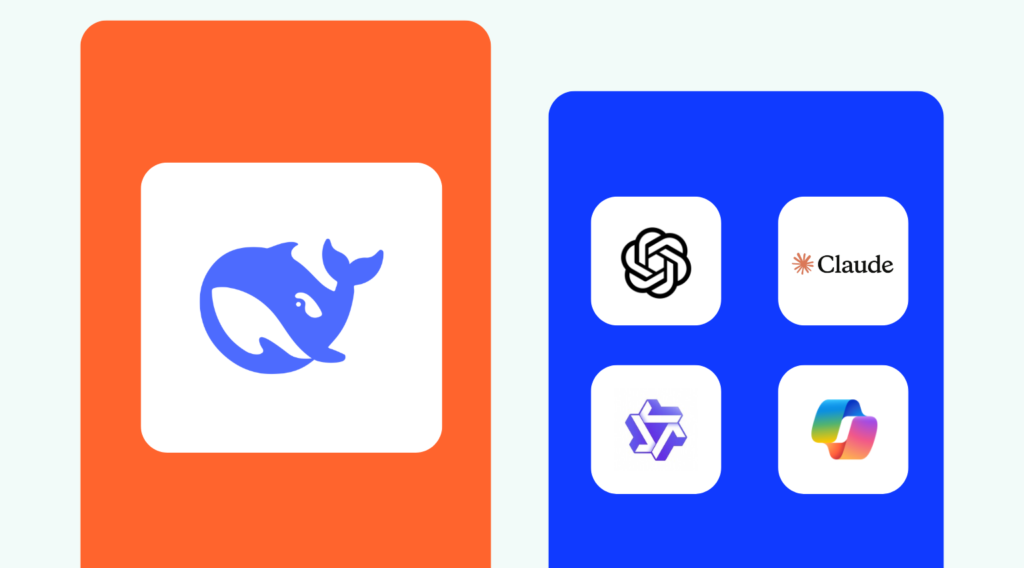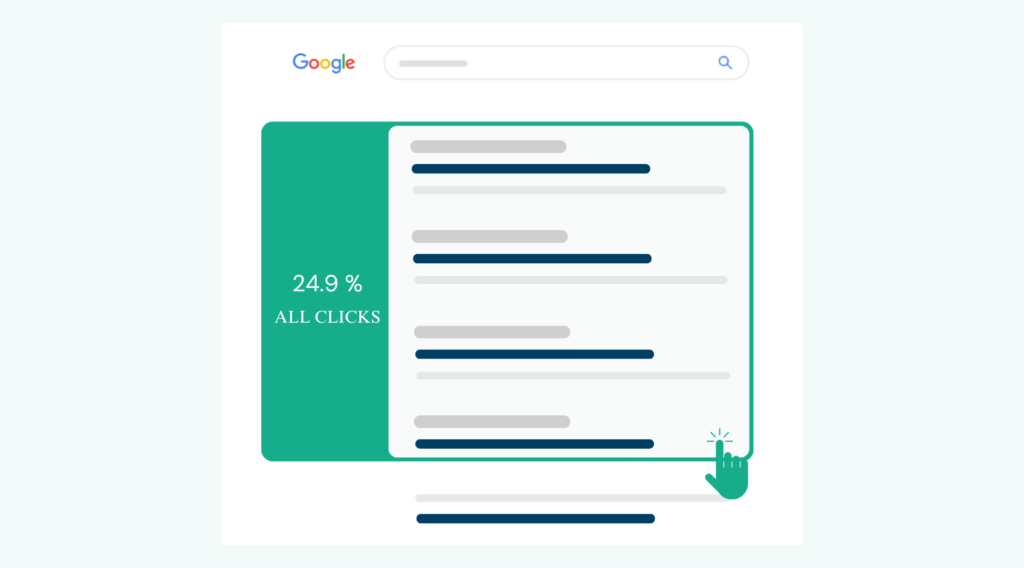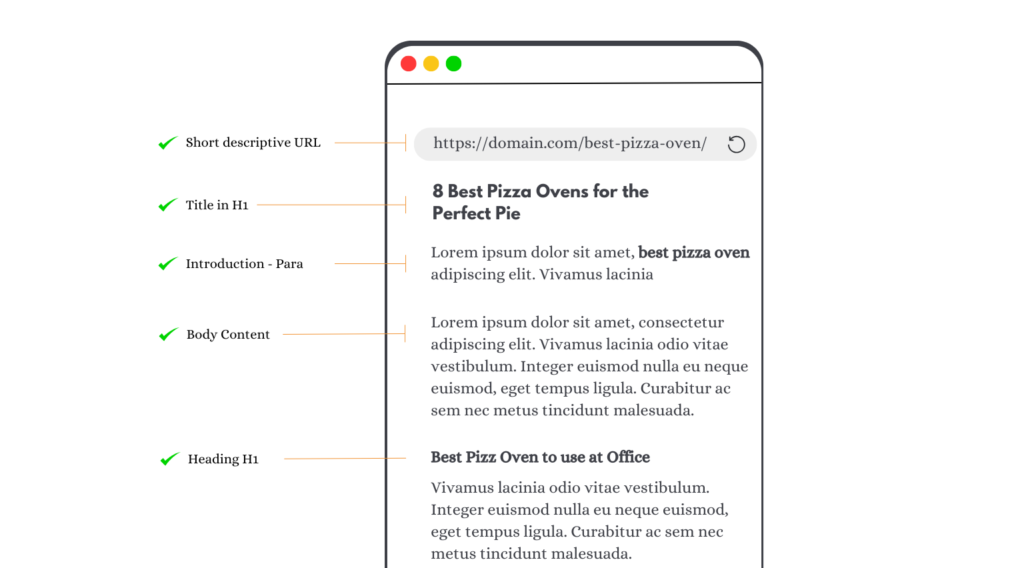To get more traffic every business wants their website to show up on the first page when people search for things related to their business. Having on the first page increases the chances of getting about 40% of clicks when a user searches for a query, which means you get lots of visitors to your website. Showing up in second and third positions gets you much less attention – only about 19% and 10% of clicks.
While having lots of people searching for your topic is important, what’s even better is getting your content to appear in what’s called a “Featured Snippet” that’s the special box that sometimes appears right at the top of Google’s results with a direct answer to people’s questions. This featured spot can bring even more visitors to your website. It is also called 0 ranking.
- Good CTR for SEO
- What is Organic CTR?
- Here is an Organic CTR Summary of Our Key Findings:
- Google's Top Result Captures 27.6% of All Clicks
- Organic CTR Spikes At Position #8… And Again At Position #2
- Going to Position One Increases CTR By 32.3%
- Top Ranking Websites Get 25.1 Clicks Per Query
- Title Tags Between 40 to 60 Characters Get The Best CTR
- Longer Keywords Typically Achieve Higher Overall Click-Through Rates
- Best Practices for Perfect CTR
Good CTR for SEO
A good way to understand click-through rate (CTR) is to think of it like customers walking past a store window. Imagine you own a small coffee shop on a busy street. If 100 people walk past your shop and 3 people decide to come in, that’s similar to how CTR works in the online world. When we say a CTR of 3% is good for websites, it means that for every 100 people who see your website link in a Google search, 3 of them click to visit your site.

You might think it sounds low at first, but remember searches see many website options when they search on Google. For example, if 100 people walk past your coffee shops before choosing one, internet users often scan through multiple search results before deciding which one to click. Getting 3 out of every 100 people to choose your site over all the other options is actually a solid performance in the digital world.
What is Organic CTR?
CTR (Click-Through Rate) shows how often people click on your website when it appears in Google search results. It’s calculated by taking the number of clicks your website gets divided by how many times it shows up in searches. According to Search Database, when your CTR goes up, Google ranks your website higher in search results, which helps bring more visitors to your site.
We looked at how often people click on websites that show up in Google search results. We studied nearly 2 million web pages and over 9 million different Google searches to understand this better. We wanted to know if things like how long a website’s title is, the feeling or emotion in the title, and the short description below the search result affect how likely people are to click on it. A company called Semrush helped us by sharing data from different Google Search Console accounts. Google Search Console is a tool that shows website owners how their sites are doing in Google searches.
Here is an Organic CTR Summary of Our Key Findings:
- When you search on Google, about 28% of people click on the very first result (Excluding Paid ads).
- People are 10 times more likely to click the first result compared to the tenth result.
- If your website appears in positions 8, 9, or 10 at the bottom of Google’s first page, you’ll get about the same number of clicks.
- Moving up #1 Page in Google results usually gets you about 3% more clicks. But this matters more at the top – moving from third to second place gets you lots more clicks while moving from tenth to ninth doesn’t make much difference.
- Whether a title has a question mark or not doesn’t affect how many people click on it.
- Website titles that are between 40-60 letters long get the most clicks.
- When people search using longer phrases (10-15 words), they’re more likely to click on results – almost twice as likely compared to searching with just one word.
- If your website address (URL) includes words related to what people are searching for, it gets 45% more clicks.
- Using positive words in your title might help – it can increase clicks by about 4%.
Google’s Top Result Captures 27.6% of All Clicks
We started our research to find out how many clicks each search result position typically gets on Google.
After looking at 2 million search results, we found that websites in the first position get way more clicks than any other position.
We also saw a sharp CTR dropoff starting on the 2nd page of the results.
Less than 1% of people (just about 0.63%) ever bother to look at the second page of Google search results. This means almost everyone only clicks on the results they see on the first page!
After Analyzing Our Refined Data, We Found That Google’s #1 Result Boasts a 27.6% CTR.
The #1 Result in Google Achieves a 10x Higher CTR Than the #10 Spot.
When people search on Google, the first website that shows up is super important! Let’s break this down:
For regular searches (like “how to make tomato sauce”), about 28% of people click on the very first result they see. That means if 100 people search for something, 28 of them will click on the first link.
It gets even more interesting when people search for specific brand names (like “Adidas” or “Oracle”). In these cases, even more people click on the first result. This makes sense because when someone types a company’s name, they usually want to go directly to that company’s website.
SEO experts (people who help websites show up better in Google) have known this for a long time – being number one on Google is way better than being second, third, or anywhere else on the page.
Remember: If you want people to find your website, trying to get to that #1 spot on Google is really important because that’s where most people click!
Organic CTR Spikes At Position #8… And Again At Position #2
When people search on Google, most of them click on the very first result. But other positions on the page can still get some visitors too! Here’s what’s interesting:
At the bottom of Google’s first page (positions 9 and 10), very few people click on these links. But something cool happens at position 8 – it gets surprisingly more clicks than positions 9 and 10!
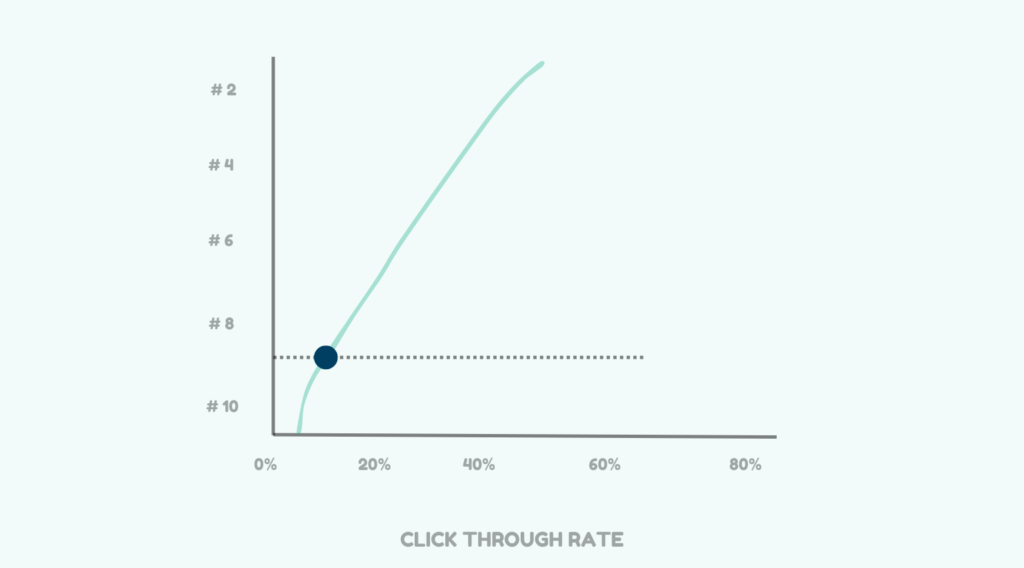
Why does this happen?
- Most people don’t scroll to the bottom of Google’s search results
- If your website moves from position 9 to position 8, you might suddenly get many more visitors
- When there aren’t any ads at the top of Google, the second result often shows up without needing to scroll down (this is what “above the fold” means)
Here’s the most important part: Just trying to get on Google’s first page isn’t good enough anymore. What really matters is getting in the top three spots, especially the first or second position. Just the top three results get more than half of all clicks from people searching!

So if you have a website, you should aim high – try to get to those top spots rather than just being happy with any position on the first page.
Going to Position One Increases CTR By 32.3%
Moving up in Google search results is like climbing a ladder – the higher you go, the more visitors you get to your website. But here’s the really interesting part:
Moving up just one spot (any spot) on Google usually gets you about 32% more clicks. But it’s not that simple! The increase in clicks depends a lot on which position you’re moving from.
Let’s look at two examples to understand this better:
- If you move from position 10 to position 9 (at the bottom of the page), you only get 11% more clicks. That’s not a huge difference.
- But if you move from position 2 to position 1 (reaching the top spot), you get a massive 74.5% more clicks! That’s a huge jump!
To make it super clear: On average, moving up one spot will get you 2.8% more people clicking on your website. But this number changes a lot depending on where you are. The biggest prize is moving from second place to first place – that gets you nearly 75% more visitors!
Think of it like this: Moving from last place to second-to-last place in a race isn’t a big deal. But moving from second place to first place is huge! The same thing happens with Google search results.
Top Ranking Websites Get 25.1 Clicks Per Query
Think of Google Search Console as a report card that shows how your website is doing in Google searches. Here’s what the research found:
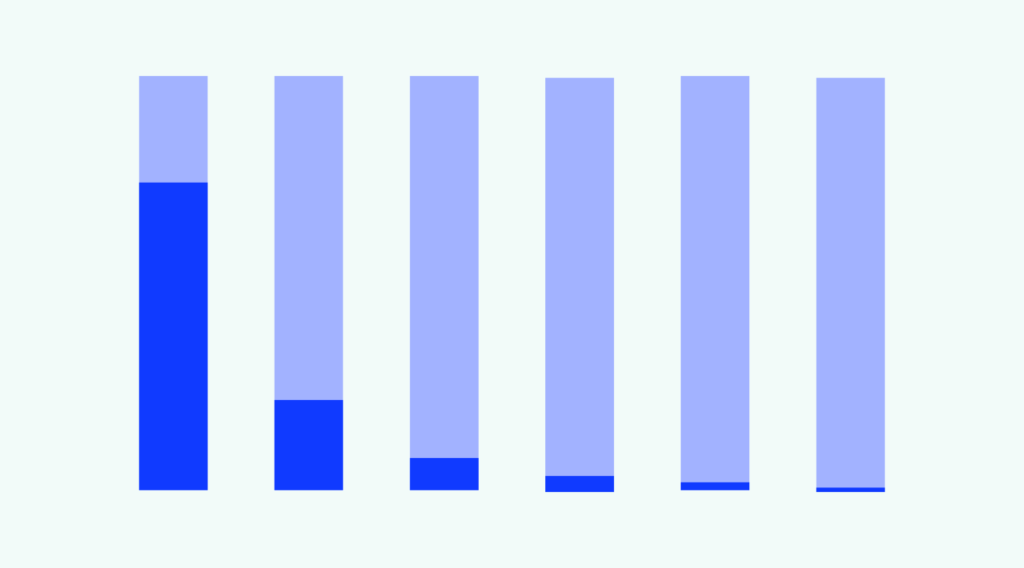
Most searches that include your website in the results don’t get seen by many people. In fact, about 90% of these searches are seen 10 times or less! On average, each search term only gets about 25 clicks.
Why does this happen?
- Most of the words and phrases your website shows up for are very specific (like “best blue running shoes for flat feet size 10” instead of just “running shoes”)
- Your website might not be showing up high enough in the results for these searches
- Or both of these things could be happening at the same time
Here’s the important lesson: Don’t get excited just because your website shows up for lots of different search terms! It’s like having a store on a quiet street – even if you sell lots of different things, it doesn’t matter if very few people walk by. What really matters is showing up for searches that lots of people actually make.
Most of your website visitors will probably come from just a few popular search terms, not from the hundreds or thousands of rarely-used search terms.
Title Tags Between 40 to 60 Characters Get The Best CTR
The title tag is like a headline for your webpage when it appears in Google search results. People have always wondered: should these titles be short or long? Well, now we have some clear answers!
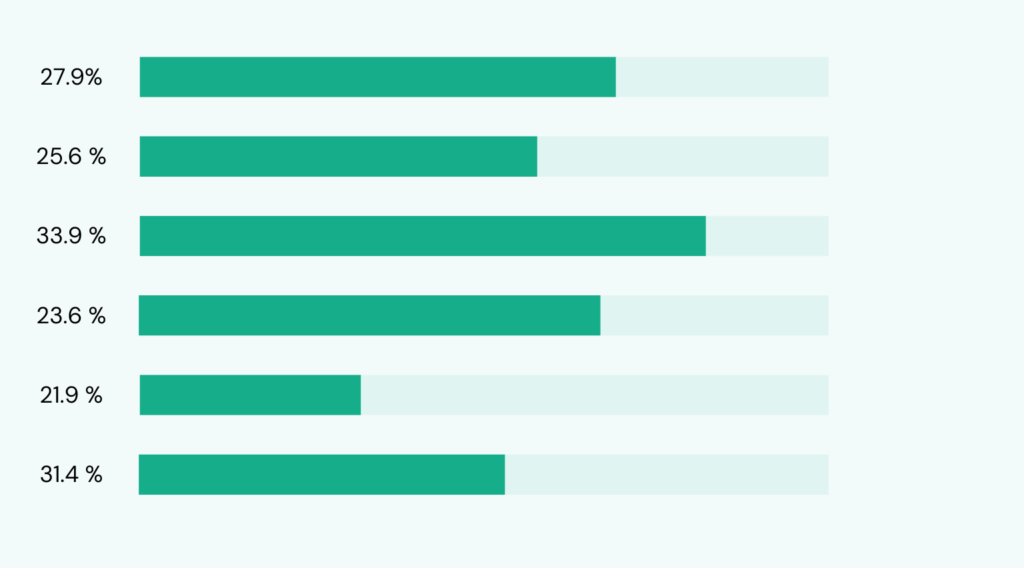
The Perfect Length:
- Best length: 40-60 characters (not too short, not too long)
- Pages with titles in this range get about 9% more clicks than pages with shorter or longer titles
Think of it like the story of Goldilocks:
- Very short titles: Don’t give enough information
- Very long titles: Can be confusing or get cut off in search results
- Medium titles (40-60 characters): Just right!
A real-world example helps explain this: The website Etsy (where people sell handmade items) did their own test. They tried different title lengths and found that shorter titles worked better than long ones.
Why does this happen?
- Short titles are easier to read and understand quickly
- Medium-length titles give enough space to include important information
- Longer titles might contain too many keywords and look spammy to readers
So if you’re making a website, aim to keep your page titles between 40-60 characters. This seems to be the “sweet spot” where people are most likely to click on your link when they see it in Google search results!
Longer Keywords Typically Achieve Higher Overall Click-Through Rates
Think about how people search on Google. Some people type just one word (like “shoes”), while others type longer phrases (like “best running shoes for marathon training under $100”). This study looked at how these different types of searches affect clicking behaviour.

When someone searches using a long phrase (10-15 words), they’re about 2.6 times more likely to click on the first result compared to when they search with just one word!
Long searches are more specific: When someone types a long search phrase, they usually know exactly what they want. For example, instead of searching “pizza,” they might search “best thin-crust pepperoni pizza delivery near downtown open right now”
When someone uses a longer, more specific search, Google can show them exactly what they’re looking for.
The big lesson here is that when people make longer, more specific searches, they’re almost twice (1.76 times) as likely to click on the first result they see. This is because they’re more likely to find exactly what they’re looking for!
Best Practices for Perfect CTR
To get more clicks from Google searches, focus on these key strategies: First, try hard to reach the top spot in search results, since the #1 position gets 27.6% of all clicks and moving from #2 to #1 can boost clicks by 74.5%. Make your page titles between 40-60 characters long, as this length gets the most clicks. Target longer, specific search phrases (10-15 words) rather than single words, since specific searches get 2.6 times more clicks. Finally, don’t worry about ranking for lots of different terms – instead, focus on ranking well for popular searches that actually bring in traffic, since 90% of search terms get very few views.
Factors that Affect CTR
- User Experience Design (UX)
- Site Load Time
- Quality of content
- SEO CTR for branded and non-branded keywords
- Target Audience and Search Intent
- Mobile Search
- Optimize for Search Engine Algorithms and Updates
- Search Volume and Popularity of Keywords
Subscribe to our Newsletter:




